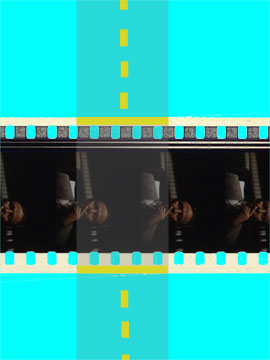|
|
This topic comprises 2 pages: 1 2
|
|
Author
|
Topic: Marking Reel Splices
|
|
|
|
|
|
|
Jason Black
Phenomenal Film Handler

Posts: 1723
From: Myrtle Beach, SC, USA
Registered: Nov 2000
|
 posted 05-12-2001 01:30 AM
posted 05-12-2001 01:30 AM





A very simple way to mark splices for breakdown is to use a piece of Permacell (?) tape at just prior to the splice. This tape is like maskingtape, only non residous, so no damage to the film. It is very plain to see and you know where the splice is coming up.Anyone who is breaking down prints, IMO, should be able to SEE the splices (or reel change) by the differnet texture/contour of the film itself. Look at a film on the platter and tell me you can't see the reels by the contour/color variations in each individual reel.... My guys build in using only clear tape anyway. Aaron, where could I go about SEEING a picture of the Splicemark tape you mentioned?
------------------
The early bird may get the worm, but the second mouse gets the cheese!
| IP: Logged
|
|
|
|
|
|
|
|
Brad Miller
Administrator

Posts: 17775
From: Plano, TX (36.2 miles NW of Rockwall)
Registered: May 99
|
 posted 05-13-2001 02:19 AM
posted 05-13-2001 02:19 AM




Company policy? What a stupid policy that is! If the projectionists at a theater are intelligent enough to not need yellow tape, the corporate guys should be pleased and not punish them to use the inferior quality of that tape. Yellow tape works best in a trash can.Also, just how often does your theaters have damages necessitating the use of "repair splices"? If it is more than about once a year, you have bigger problems to worry about than the kind of tape being used. Sorry for the rant Randy, but those two comments just strike me as bas-ack-wards. Great illustration though.  Also, if the SDDS reader is aligned properly, you can use solid opaque tape and not have a dropout. If that splice above would drop the SDDS audio, your reader is not aligned properly.
| IP: Logged
|
|
Randy Stankey
Film God

Posts: 6539
From: Erie, Pennsylvania
Registered: Jun 99
|
 posted 05-13-2001 11:42 AM
posted 05-13-2001 11:42 AM




Sorry, most of us don't have the $$ that you do and can't buy a Metric splicer. When we come across lab splices, busted sprocket holes and other random junk like that we have to use our lowly tape splicers to repair it.I couldn't give a rat's ass about SDDS, personally. I only have one of them to work on. Basically I hook up the computer to it, take the readings and write them in my reports. When the thing stops working I'll go put new LEDs in it. If I have problems with it that require more than that I'll do my homework. Until then I could care less if the damn thing fell off the face of the earth... Consequently if there are splices covering the SDDS... who cares. I started using the clear part of the zebra tape when we started getting the Neumade tape that didn't have the dashed cross bar. Up until that time I was just carefully placing the tape so that the soundtrack was in the clear space between the dashes. If you look closely at the Neumade tape without the dashes, the edges of the tape are "dithered" (or whatever) I guess the idea is that it will make less noise going through. Still, it sounds like a bowl of Rice Krispies to me. Finally after a couple of times I got peeved off and started using clear tape and using a SharpieŽ marker to put a dot on the tape so I could tell the differences between rell-changes and repairs. Well, there were a couple of people who couldn't find the splices without the zebra tape and they whined to management. I went grumbling off to the work bench to make up the next movie and I just thought of that out of the blue. I've been using it that way ever since. The whiners are satisfied and I can do a good job of putting the films together.
| IP: Logged
|
|
|
|
Aaron Sisemore
Flaming Ribs beat Reeses Peanut Butter Cups any day!

Posts: 3061
From: Rockwall TX USA
Registered: Sep 1999
|
 posted 05-13-2001 06:27 PM
posted 05-13-2001 06:27 PM




>>Aaron, where could I go about SEEING a picture of the Splicemark tape you mentioned?<<
http://www.cinprod.com/images/products/tape.jpg It's the red (actually magenta) colored tape. If you'd like I can send you a roll to try out... Aaron
| IP: Logged
|
|
|
|
|
|
|
|
|
|
|
|
All times are Central (GMT -6:00)
|
This topic comprises 2 pages: 1 2
|
Powered by Infopop Corporation
UBB.classicTM
6.3.1.2
The Film-Tech Forums are designed for various members related to the cinema industry to express their opinions, viewpoints and testimonials on various products, services and events based upon speculation, personal knowledge and factual information through use, therefore all views represented here allow no liability upon the publishers of this web site and the owners of said views assume no liability for any ill will resulting from these postings. The posts made here are for educational as well as entertainment purposes and as such anyone viewing this portion of the website must accept these views as statements of the author of that opinion
and agrees to release the authors from any and all liability.
|

 Home
Home
 Products
Products
 Store
Store
 Forum
Forum
 Warehouse
Warehouse
 Contact Us
Contact Us




 Printer-friendly view of this topic
Printer-friendly view of this topic













 )
)




